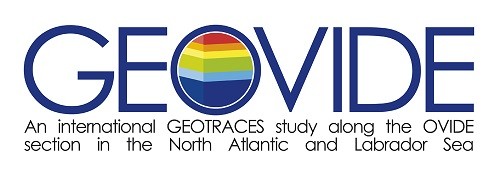Person in charge: E. Bucciarelli (LEMAR)
Participants: F. Planchon, G. Sarthou, C. de la Rocha, ANR research associate, PhD student (LEMAR), F. Lacan, C. Jeandel, P. van Beek, C. Pradoux, V. Bouvier, M. Souhaut (LEGOS), P. Lherminier (LPO), E. Achterberg (NOC, Southampton, UK), F. Dehairs and Post-doc (VUB, Belgique), G. Henderson (Univ. Oxford, UK), E. Boyle (MIT, USA), P. Masqué and M. Castrillejo (Univ. Barcelona, Spain).
Collaborators: D. Cossa (Emérite IFREMER), L.-E. Heimbürger (GET, Toulouse),
Studying the TEIs in the dissolved phase is crucial, notably to better know and quantify (i) the exchange with the particulate phase (task 4), (ii) the various sources to the ocean, and (iii) the TEI impact on the carbon cycle. It is very challenging to provide a high-quality dataset of TEIs in the dissolved phase, since their concentrations are extremely low and some of them are prone to contamination during sampling, filtration, and analysis. Samples will be taken for intercalibration as recommended by the GEOTRACES programme, at cross-over stations with two other GEOTRACES cruises: GA02 (2010, PI: L. Gerringa, NIOZ, NL) and the Canadian Arctic GEOTRACES cruise: “Biogeochemical and tracer study of a rapidly changing Arctic Ocean (2015, PI: R. François, UBC, Canada). TEI concentrations and speciation in the dissolved phase will be fundamental in order to better constrain their bioavailability (Wu et al., 2001). Moreover, a better quantification of their fluxes is a key component when studying the TEI cycles. Fluxes of dissolved TEIs will be estimated using their vertical profiles, together with vertical and horizontal eddy diffusivity coefficients and/or water mass transport velocities. Atmospheric inputs will be estimated using aerosol concentrations (task 4) as well as dissolved concentrations of atmospheric tracers. Margins inputs will be estimated with the help of sediment input tracers (e.g. Nd and Ra). Dissolved TEI residence times will then be estimated and give us a better estimation of their reactivity in the ocean.
Samples will be taken from the Go-Flo clean rosette for the parameters sensitive to sampling contamination (trace metals, Hg, Fe isotopes, Pb stable isotopes) and from the classical CTD-rosette for the other parameters (234Th, REEs and Nd isotopes, Ra isotopes, δ15N, δ18O, Pa and Th isotopes, 210Pb/210Po, Si isotopes). On board dissolved Fe and dissolved Al measurements, within 24h of sampling, will help to check for contamination of both the clean sampling and filtration systems, since both elements are prone to contamination. Several members of the GEOVIDE consortium participated to previous GEOTRACES cruises and intercalibration cruises (ANTXVIII, SAFe, GEOTRACES) and have all the necessary skills to complete successful clean sampling and analyses of the dissolved phase.
